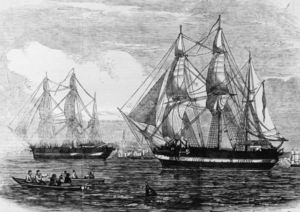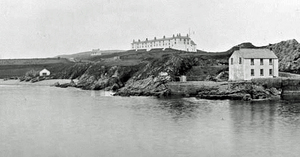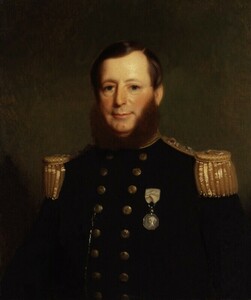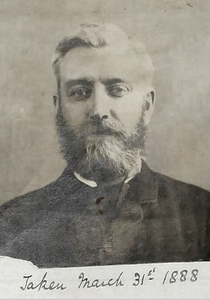SIBBALD, JOHN JAMES ALEXANDER
c.1809-1868 from Scotland
naval commander, surveyor general, clerk of the courts and acting colonial secretary, was born In Melrose, Scotland c.1809. During his service in the Falklands, he was styled as ‘Captain John Sibbald, RN.’
Sibbald entered the Royal Navy on 5 September 1821, and he passed his seamanship examination in 1828. He obtained his first commission on 10 January 1837 when he became a Lieutenant in HMS Thalia, the flagship of Sir Patrick Campbell (1773-1841) at the Cape of Good Hope. On 3 August 1833, he was appointed to serve in HMS Edinburgh, serving under Captain William Wilmott Henderson (1788-1854). The ship was employed at Portsmouth and on the North America and West India station. He returned to England on 13 August 1839. He served as Second and First Lieutenant in HMS Erebus (a modified bomb ship) under Captain James Clark ROSS (1800-1862), on an expedition voyage of discovery to the Antarctic seas. (Source: A Naval Biographical Dictionary by William Richard O'Byrne). Also, as part of the expedition, was Captain Thomas Edward Laws MOORE (c.1820-1871), First Mate of HMS Terror. Thomas Moore later served as the Governor of the Falklands from 1855-1862.
Cape Sibbald, (73°54′S 165°23′E) in Antarctica was sighted in February 1841 by Captain Ross and was named after John Sibbald. The James Clark Ross Expedition came to the Falkland Islands, to refit and refresh, during the winter months, arriving at Port Louis in April 1842. On 8 September 1842 Sibbald and six other officers moved ashore to maintain the tidal and magnetic observatory which had been established by James Clark Ross at Port Louis. Terror and Erebus left the Falklands in November 1842, and they arrived back in England on 4 September 1843. Sibbald was promoted to the rank of Commander on 4 October 1843.
Sibbald married Matilda Lucretia Taplen (1821-1893), daughter of Lieutenant Thomas Taplen and Maria Taplen née Moyes 16 October 1844. Matilda’s sister, Emma Jane, was married to Captain Thomas Moore.
On 10 February 1849 John Sibbald was appointed Inspecting Commander of the Dundalk Coast Guard station in County Louth, Ireland. The family lived there from 1849 to 1853. Serving ashore for a naval officer meant that they only received half-pay, so the Sibbald family lived in straightened financial circumstances. In later years Sibbald’s son Andrew (born at Dundalk), who became a journalist, wrote about family life in an article for the Army and Navy Magazine, Volume 3, entitled ‘Five Years in the Falkland Islands,’ in which he stated that his father ‘was feeling the sad reverse of shortened means’. Sibbald’s brother-in-law, Thomas Moore came to the rescue when he asked Sibbald if he, and his family, would accompany him to the Falklands to serve as a government official.
My father, Captain John Sibbald, R.N., having some years ago completed his term of employment in a government appointment, and feeling the sad reverse of shortened means in consequence, was gladdened on opening a missive brought by the postman, telling of a near relative being appointed Governor of the Falkland Islands, and asking if he would accompany him. Poverty, tugging hard, said " Yes." My father, who had been to the spot but a few years previously, having served as First Lieutenant in the Antarctic Expedition under Sir James Ross, and consequently having passed some years not only there but in the extreme southern latitudes, felt a repugnance, which was eventually overruled. He obtained leave from the Admiralty, and on a bright morning in August the anchor was cast in Ply[1]mouth Sound on board a merchant vessel, the Frowning Beauty, which we hired for the purpose, and proceeded to sea, having H.M.S. Alarm, Captain Curry, sent by Government as our escort.
When the Moores moved to the Falkland Islands, the Sibbalds went with them, sailing from Plymouth on 12 August 1855, on board the 360-ton British Barque Frowning Beauty which arrived in Stanley on 7 November 1855, after a journey lasting 66 days. There were 21 passengers onboard the ship, including Thomas MOORE, the new Governor of the Falkland Islands, and his family. His wife, Emma Jane Moore, was Matilda Sibbald’s sister.
The Moores and Sibbalds arrived at a colony that was in some disarray, with a bleak unwelcoming atmosphere, which Governor Moore set about cleaning up. Although Moore was one of the very few governors to have seen the Falkland Islands before his appointment, it is clear that initially he found things difficult and had trouble settling down. He wrote home to England: 'When I first came here everything looked deplorable, drunkenness was the prevailing habit'. He described the settlers as ‘worse than savages.’ Relationships between leading members of the community were initially very strained and the new governor and his family quarrelled with his colonial secretary and with a leading landowner Captain PACKE. The Sibbald family lived in part of the old Barracks. Governor Moore appointed John Sibbald as Clerk of the Courts on 14 November 1855. On 15 March 1856 Sibbald was further appointed as a Justice of the Peace for the Falkland Islands and their Dependencies, and on 22 March 1856 he was appointed Acting Colonial Secretary. Life in the Falklands during this period was difficult - in 1855 a typhus epidemic hit Stanley, and in all 19 children perished between 8 May and 30 November 1855; approximately 20% of the children under 16 years of age who were living in Stanley. The school was closed for seventeen weeks.
On 29 August 1858 the new Colonial Manager of the Falkland Islands Company (FIC), James LANE, arrived in the Falklands, and he found that his predecessor Thomas HAVERS had left the accounts in confusion. He was hard working and efficient and although he put the FIC affairs on a sound footing, he was also unpopular and ill-natured in the Colony. Lane was very critical of Sibbald and far from sympathetic towards him in his public comments and in private correspondence. Lane remained the FIC Colonial manager until 1865.
The wife of Governor Moore, Emma, at the age of 43, died on 10 April 1859 from angina pectoris and was buried in Stanley cemetery.
On 27 June 1859 James Lane advised the London Office of the FIC that:A shameful proceeding came to my knowledge by Captain Sibbald, as the instrument, not unconnected, I feel assured, with the Governor – looking to Captain and Mrs Sibbald being his brother-in-law and sister-in-law, the Storekeeper might have been induced to fall into the trap. I believe Captain Sibbald himself (probably when stupid from drink which is not unusual, for he is a lost man) made [up] some story to Mr Brooke, on which the Warrant [was] issued on the 28 May - that one or both tried to find export facto grounds to justify them.
Matilda Sibbald and her four children departed the Falklands in February 1860 onboard the 235-ton British barque Sunrise. They went to live in Plymouth.
On 11 January 1862 Sibbald was again appointed Acting Government Clerk on half pay of £87-10, as well as his annual salary of £145 as Clerk of the Courts and half pay of 10/6d a day as a Commander in the Royal Navy. But in a despatch to the FIC Board, dated 22 September 1862, James Lane advised the London Officer that ‘Captain Sibbald had had a stroke of paralysis and if he lives will be quite unfitted for his office of Clerk of the Court’. Despite this assessment, by September 1866 Sibbald was filling the offices of Colonial Secretary, Surveyor General and Clerk of the Courts.
Governor Moore was succeeded by Governor James MACKENZIE in November 1862, and he was succeeded by Governor Sir William ROBINSON in May 1866. Sibbald continued to serve both governors in various capacities – including as Clerk of the Courts and also a Notary Public and Registrar of the Vice Admiralty Court.
Sibbald’s son described the rathe restricted life in the Falkland Islands thus:
During our sojourn in Stanley, we made many excursions into the camp, the irregularities of terra firma adding much to the pleasure. The entertainments being rather scarce, consisting of a ride to the camp, an occasional boating expedition, and the social gatherings amongst the few who came within the range of visiting with the Governor and officials, a proposal to get up a riding party was invariably welcomed. There is something so exhilarating in the air, it is so clear. Nothing could exceed to the people of Stanley, who led a rather moping life, the joy and delight of being mounted on the trained native horses.
On 4 January 1867 Sibbald, wrote to Governor Robinson advising him that he had been more than eleven years in continuous service in the Falkland Islands and requesting twelve months leave of absence to proceed to England. The Executive Council minutes of 7 January 1867 recorded an application from Sibbald, Clerk of the Courts, for leave of absence for one year to proceed to England on urgent private affairs – possibly to deal with the mental health problems of his eldest child, John Sibbald Jnr. The members of Executive Council were unanimous that after eleven years continuous service he was entitled to the leave and that it would commence from his departure from the Falkland Islands. The Governor wrote to Sibbald the same day advising that he was happy to grant his application and that the usual certificate would be forwarded to him as soon as he advised the date of his intended departure. On 5 February 1867 Sibbald advised the Governor that, with his permission, he intended departing in the mail packet Foam at the end of the month to Montevideo.
On 13 February 1867 Governor Robinson wrote to the Secretary of State informing him that he had granted twelve months leave of absence and that the maximum leave with half-pay. grantable to Sibbald, was eighteen months - therefore he was authorised to apply to the Secretary of State for an extension of six months should he require it. The Foam sailed on 2 March 1867.
On 3 May 1867 it was noted in the Falklands that Sibbald had been seen in England and appeared to be in very feeble health, so much so as to render him unfit for the resumption of any active duties and that he should be allowed to retire. On 18 June 1867 the Secretary of State advised Governor Robinson that the Lords Commissioners had consented to allowing Sibbald to retire and that a pension should be assigned to him at once.
Matilda and John Sibbald had four children; their eldest daughter was Maude Mary Sibbald, who was born in 1846 in Plymouth, England. She married George Willridge, a wholesale tea merchant, from Ireland, and they lived in London. George was much older than Maude, and he became ill and died the following year. She died in 1905 in Eastbourne. The couple had no children. Their second son was Andrew Thomas Sibbald, born 5 June 1852 at Point House, Dundalk, County Louth, Ireland. He became a journalist, and he emigrated to America in 1890. The Sibbald’s second daughter was Ethel Emma Sibbald, born on 18 October 1859 in Stanley and baptised 3 January 1860 in Holy Trinity Church (the precursor to the present cathedral church of Christ Church). Ethel was married to George John Welch, farmer, on 8 October 1889 at Holy Trinity, Richmond. Ethel died on 12 December 1899 at Mount Pleasant Farm, Norton St Philip, Somerset. The couple had no children.
The Sibbald’s eldest child was John Gordon Edward Sibbald who was born on 9 September 1845 at Laira, near Plymouth, Devon, and baptised on 16 October 1845 in the parish of Charles the Martyr, Plymouth. In 1862 he took and passed the Civil Service exam and was appointed a third-class clerk in the Admiralty in 1862. Very sadly for the family, John Sibbald Jnr. had serious mental health problems. He was admitted to Bethlem Hospital on 9 May 1868, after not sleeping for four weeks, and suffering from depression, memory loss and he had attempted suicide. The hospital reported that he was overworked and very thin. He responded to the kind treatment he received, and he was discharged from the hospital on 11 December 1868 – just six weeks before his father died. By the time he was 38 John Jnr. was living in his family home in Richmond. He was re-admitted to Bethlem Hospital on 4 March 1888. He had been ill for about a month beforehand, and the death of his aunt (Mary Taplen) was given as one of the causes, together with his general fears about fire and death. He was discharged in November 1888. The 1901 Census listed John as being a visitor of his brother-in-law at Mount Pleasant Farm, near Okehampton, Devon. John Sibbald Jnr. aged 75, died on 8 August 1920 from senile dementia and exhaustion at Mount Pleasant Farm. He had no children.
Commander John Sibbald Snr, aged 59, died from malnutrition on 24 December 1868 at 32 Redcliffe Road, West Brompton after eighteen months of paralysis. He was buried on 30 December 1868 in Brompton Cemetery, West Brompton, Royal Borough of Kensington and Chelsea.
Matilda Sibbald, aged 71, died on 18 January 1893 and was buried with her husband on 21 January 1893.
Comments
Revisions
June 2023 Biography first added to Dictionary



